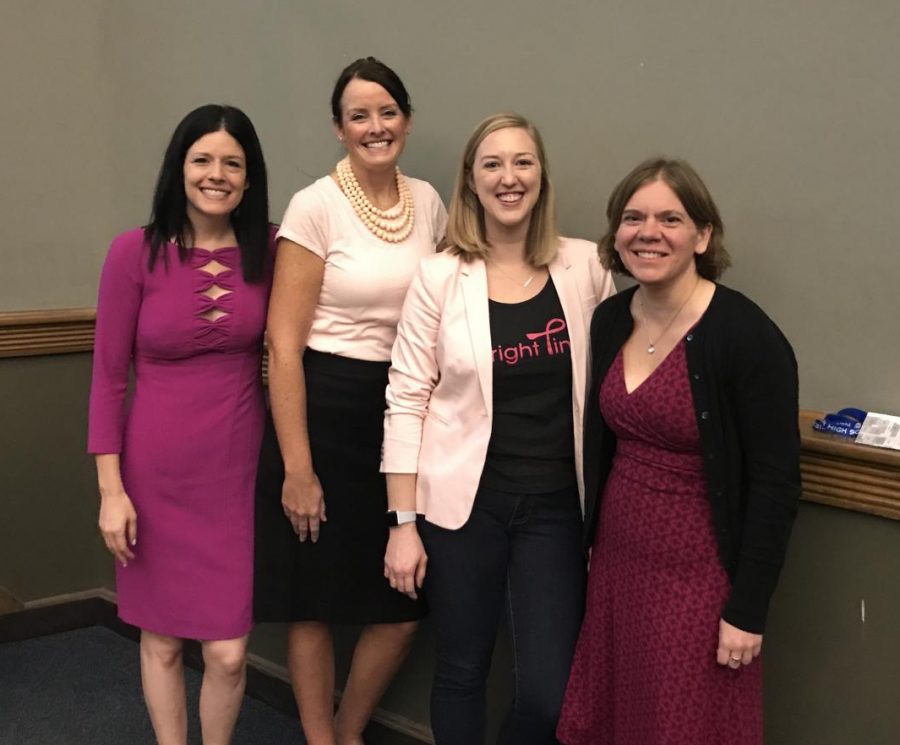Bright Pink assembly educates only girls adviseries on early detection
Cancer awareness organization founder talks to junior and senior girls
On Oct. 16, New Trier partnered with Bright Pink, a national non-profit organization, for a girls junior and senior advisery assembly, focused on early detection of breast and ovarian cancer in young women, raising questions on the school’s position in not including male adviseries.
Lindsay Avner the founder of Bright Pink was recently named as one of the most influential “Women Doing Good” by SELF Magazine.
“One of the things that is incredible and different from generations of women before us, is that we have the chance to not only know our risk, but to do something about it,” said Avner.
“There are so many things in life that we can’t control, so teaching somebody what their risk is for breast and ovarian cancer and then help them understand what they can do differently is such an amazing opportunity and gift,” said Avner.
Already, Bright Pink has raised more than $1.3 million dollars and in 2010, was named the No. 1 Charity in Chicago by Chicago Scene Magazine.
However, many students questioned why only girls adviseries attended the assembly.
Sophomore Shane Michelon said, “Even though breast cancer, in most people’s minds, relates only to females, it really influences everyone, which is why I think both females and males should have been included in the assembly.”
Senior Kai Reinhard agreed and added, “More often than not when people think of who gets breast cancer, they think of females, who are the majority of victims, but New Trier needs to recognize the importance of everyone understanding the causes of breast cancer, how to check for it, and the fact that males can also get it. A lot of men, including myself, don’t know enough about it to even check for it or just be more aware of it.”
Addressing this discrepancy, Senior Girls Advisor Chair Susie Paunan said, “The reason behind not including boys wasn’t because we didn’t want them to be a part of the assembly, but more so a logistics component. It’s unrealistic to fit the entire student body in the Gaffney auditorium.”
“Also, Bright Pink has mainly focused on women’s physical health and detecting symptoms of breast and ovarian cancer early on. If we included boys, the entire program would have to be altered to fit everyone’s mentality,” added Paunan.
Junior Girls Advisor Chair, Patricia Sheridan said, “In theory, having an integrated all gender assembly could have worked, just the individual aspect in structuring women to support each other, would have changed. I believe boys can still be impacted by it, especially if they have sisters and moms. I just think this particular assembly for Bright Pink, the main concern was helping young women acknowledge the disease.”
Although male adviseries weren’t included in the assembly, the school has found other ways to increase breast cancer awareness this month by encouraging various sports teams, including the field hockey team to wear pink.
“We’ve been doing this the past 4 or 5 years. I just think it’s important we spread awareness throughout our team to show other teams to get the message going and in the end raise money,” junior field hockey player Camille Scrine commented.
Scrine’s teammate, junior Francesca Caruso, also noted the importance in “showing our support to those affected with breast cancer, which touches so many people.”
In addition to sporting bright pink gear before and after their games, Caruso noted “that by wearing and selling T-shirts for the program, we raised both money and generated curiosity. Lots of people would ask what connection we had to the shirts and what organization we were donating the money to.”
According to Sheridan, as students continue to contemplate their futures for college and careers, Avner’s personal story– undergoing a double mastectomy at 22, the youngest woman to do so at the time– “really encourages women to be proactive in reducing their risk by looking at their family history, diet, etc. and being more active in knowing their bodies.”







































